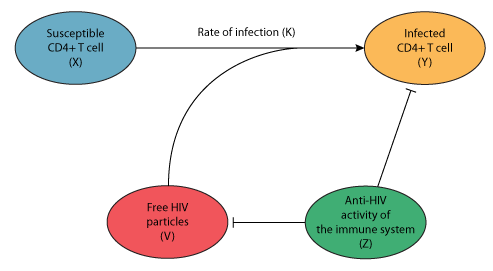Schenzle, 1994
Model Status
This CellML model runs in OpenCell and COR but does not recreate the published results (figure 3). The units have been checked and they are consistent. The equations appear to match those in the paper (7a-7e) and the parameter values have been taken from section 7 of the paper (page 2075). The CellML model simulation output fails to oscillate.
Model Structure
ABSTRACT: The idea is put forward and analysed numerically, that within an infected person HIV evolves to increase its reproductivity within the population of CD4+ cells. A mathematical model predicts initial viremia and CD4+ cell drop after HIV infection and thereafter a slow progressive decline in the number of CD4+ cells, although for an extended period HIV is kept at a relatively low level by an active immune response. The time span T until the number of CD4+ cells falls below 20 per cent of its normal value depends on several model parameters. Assuming Gaussian distributions for these parameters, the model predicts a distribution function for T which resembles the observed distribution function for the incubation period to AIDS.
The original paper reference is cited below:
A model for AIDS pathogenesis, Schenzle D, 1994, Statistics in Medicine, 13, (19-20), 2067-2079. PubMed ID: 7846411
 |
| A schematic diagram showing how susceptible T cells are infected by free HIV particles at a rate K to become infected T cells. This process is influenced by the anti-HIV activity of the immune system against infected T cells and HIV. Note: X: The number of susceptible (non-infected) CD4+ T cells, Y: The number of HIV-infected CD4+ T cells, V: The number of free HIV particles, Z: The anti-HIV activity of the immune system towards removing infected CD4+ T cells and HIV, and K: The rate at which HIV infects susceptible CD4+ T cells. |
